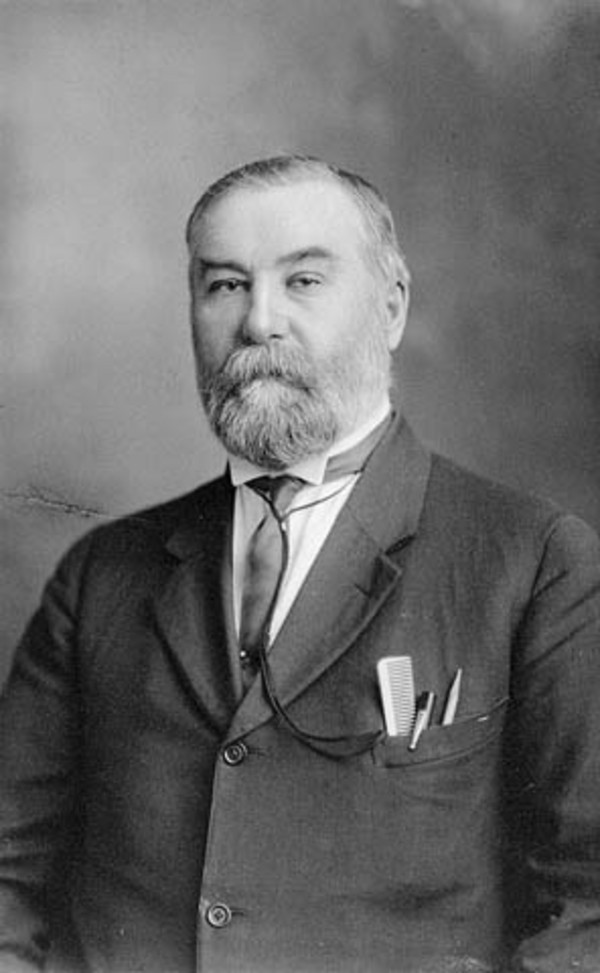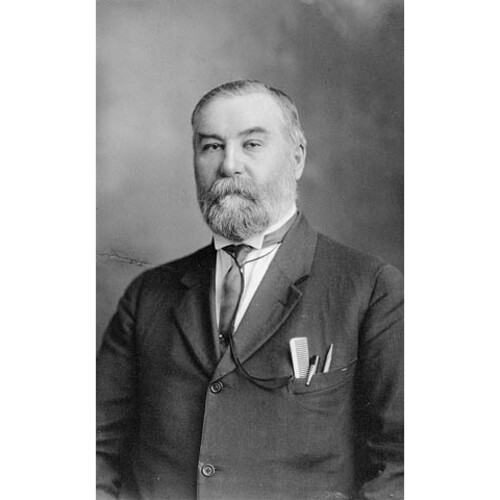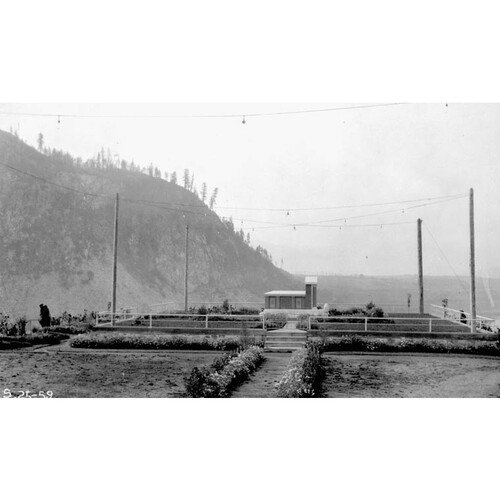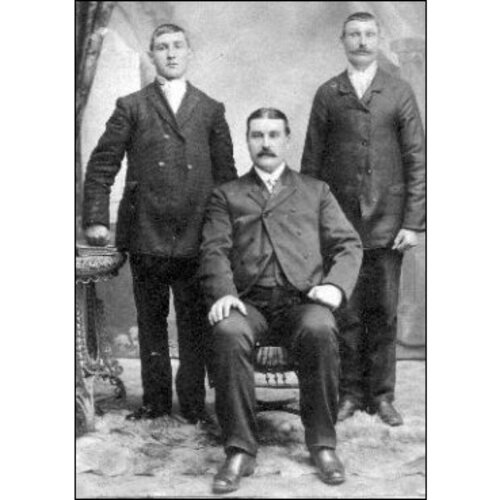VERIGIN, PETER VASIL’EVICH, Doukhobor leader; b. 11 July 1859 in Slavianka (Azerbaijan), eighth of the nine children of Vasilii Luk’ianovich Verigin and Anastasiia Vasil’evna Kalmakova; m. 1879 Evdokiia Grigor’evna Kotel’nikova, and they had one son, Peter Petrovich Verigin*; d. 29 Oct. 1924 in Farron, B.C.
Peter Verigin’s paternal ancestry is traceable to a family of Old Believers, those who refused to accept the liturgical reforms of the Russian Orthodox Church in the mid 17th century. His mother was the granddaughter of Savelii Kapustin, leader of the Doukhobors from 1802 to 1820 in the Molochnye Vody (Milky Waters) region of what is now southern Ukraine. A Russian Christian sect of uncertain origin, the Doukhobors had come to the attention of tsarist authorities in the 1750s. The name Doukhobor, meaning spirit wrestler, is said to have been attributed to its members in the 1780s by an Orthodox bishop who described them as fighting against the Holy Spirit. The sect adopted the name, claiming to wrestle with and for the spirit of God which dwelt in each believer. It rejected the Orthodox Church and the need for priests, sacraments, and the Bible, since each person could be guided by the spirit within. Doukhobor beliefs were embodied in a collection of orally transmitted teachings, especially psalms and hymns, called the Living Book. During various periods in its history the sect also held pacifist and egalitarian views. Although it refused to recognize any external authority, it looked to its own leaders, who were considered to be divinely chosen. Severely persecuted by the tsarist government, Doukhobors from what are now western Ukraine and southern Russia were resettled in the Milky Waters region in 1802; they were joined by co-religionists from other parts of the Russian empire. The sect prospered in its new home. Starting in 1841, about 4,000 members were again forced into exile, to various parts of the Caucasus Mountains (in present-day Azerbaijan, Georgia, and Turkey).
Fairly well off, the Verigins enjoyed a degree of prominence in the Doukhobor community of the Caucasus. Vasilii ensured that at least his three youngest sons, including Peter, received an elementary education. In 1864, when Peter’s cousin Petr Ilarionovich Kalmykov died, his leadership of the Doukhobors devolved to his widow, Luker’ia Vasil’evna Kalmykova. A strong leader, she maintained solidarity among her followers and a working peace with the tsarist authorities. She took notice of Verigin, a handsome and intelligent young man, marking him as one destined for “holy work.” In the early 1880s she ordered him to divorce his pregnant wife and summoned him to her personal service. Verigin’s intellectual prowess was widely noted by his contemporaries and would be mentioned frequently by later commentators. In 1968 historians George Woodcock* and Ivan Avakumovic, citing an eyewitness, were to describe him as a “powerful personality with a mind that was quick, subtle, and capable, even if it was not profound.” His rapid rise in Kalmykova’s entourage aroused much resentment. When she died childless in 1886, Verigin was one of the major contenders for the sect’s leadership in the unprecedented struggle that ensued. Even though his opponents managed to have him arrested on trumped-up charges in January 1887 and sent into exile late that summer, he was still acknowledged as leader by the vast majority of Doukhobors, who came to be known as the Large Party (estimated at between 5,000 and 7,000 persons); the Smaller Party refused to accept his leadership.
During 15 years of exile, first in Shenkursk, near Archangel (Arkhangel’sk), Russia, and then further north in Kola, near Murmansk, once more in Shenkursk, and finally in the Siberian village of Obdorsk (Salekhard), Verigin underwent a great deal of soul-searching. Influenced by his encounters with exiled revolutionaries and anarchists, as well as by his wide reading, including the works of Count Tolstoy, he laid new emphasis on a long-held Doukhobor tenet that violence, along with other human vices, was to be rejected at all costs. His ideas were conveyed back to the Caucasus by followers who paid him frequent visits and brought him money to supplement his earnings, allowing him some comfort and permitting him to feed the poor. At the end of 1893 he sent his adherents a manifesto. It called on them to refuse military service, divest themselves as much as possible of personal property (thus reviving an earlier tradition of communal holdings), and abstain not only from the consumption of alcohol and tobacco, but also from eating meat. This last directive led to a serious schism of the Large Party into Fasters (postniki) and Meat-eaters (miasniki). The Meat-eaters, sometimes known as the Middle Party, continued to acknowledge Verigin as their leader, but declined to accept his more radical views. Verigin also called on his flock to practise celibacy during the period of instability (this exhortation would be rescinded on their emigration to Canada). He proposed a new name for the group, the Christian Community of Universal Brotherhood (CCUB), which would become the official name of the Doukhobor community in Canada.
In 1895 Verigin ordered his followers to collect whatever weapons were in their possession and, on 11 July (29 June by the Orthodox calendar), to burn them in a mass demonstration of the sect’s rejection of violence. The burning of arms had a practical as well as a symbolic significance. He preferred to see his adherents suffer immediate repression than witness a prolonged conflict with authorities that would be doomed to failure. Several years of persecution by the government ensued; many Doukhobors were exiled to remote villages in the Caucasus, those refusing military service were sent to penal battalions, and others suffered beatings or imprisonment for their beliefs.
During Verigin’s exile the Doukhobors’ plight had come to the attention of interested outsiders – especially English Quakers – in large part through Verigin’s correspondence with Tolstoy, who had come to see in the sect’s pacifist, communal, and vegetarian lifestyle a practical embodiment of his own philosophy. Articles published in western papers by Tolstoy and his followers met with a sympathetic response from Prince Kropotkin, a Russian anarchist who had travelled extensively in Canada. Prompted by letters from both Tolstoy and Kropotkin, James Mavor, a professor of political economy at the University of Toronto, made enquiries of the minister of the interior, Clifford Sifton, as to the feasibility of bringing the Doukhobors to Canada. As a result of his negotiations, some 7,500 immigrants, mostly members of the Large Party, arrived during the winter and spring of 1899. They were granted homesteads in two colonies in the District of Assiniboia (another one was added later in the District of Saskatchewan). In a letter to Tolstoy on 16 Aug. 1898 Verigin had declared that he was opposed in principle to emigration, but resigned to it if no better option was available. At first prohibited from joining his followers, he was finally allowed to leave Russia in July 1902, when his last term of exile ended.
The months preceding Verigin’s coming to Canada were marked by a troublesome incident there. Members of the sect who would later call themselves Freedomites (Svobodniki) or Sons of Freedom adopted an extreme interpretation of their leader’s call to self-renunciation, turning their farm animals loose and destroying or giving away almost all personal possessions. More than 1,000 set out on a trek from the colonies near Yorkton (Sask.) in search of a place where they could live free of external constraints. In mid November police in Minnedosa, Man., halted the march and returned men, women, and children, some by force, to their settlements.
At his arrival in Winnipeg on 22 Dec. 1902 Verigin was described by a journalist of the city’s Manitoba Free Press as “a splendid type of his race. Tall and strongly built, and of erect and graceful carriage, he would attract attention among hundreds of good-looking men.” His presence had a calming effect on his flock. On 12 Jan. 1903 he explained to Tolstoy that he had defused the trouble the radicals had caused by telling them that their “motives of self-sacrifice . . . are legitimate and precious ones, but there is no need to let the children go hungry and cold, so for the time being why not remain with all the rest of the brethren and teach them?” He added that “those with families took this explanation too as a revelation from God.” It was not long before his Canadian followers, emphasizing what they perceived as his spiritual strength, began calling him Gospodnii (meaning Godly or belonging to the Lord, although frequently mistranslated as Lordly) – a title which had originally been bestowed on him by Luker’ia Kalmykova.
Soon after Verigin’s arrival in Canada, he purchased land near the Doukhobor communities and established a village which he named Veregin (Sask.); it would become the group’s administrative centre. His ability as a leader was immediately noticeable, as he combined the duties of spiritual leader with the task of managing the community’s financial and social development. His pragmatism guided him in the search for compromises with Canadian authorities in matters of Doukhobor rights and responsibilities. The issue of land registration and ownership was particularly thorny. His adherents had settled in 20 small villages and they cultivated the surrounding fields. Under his leadership the number of villages grew to 57. Initially reluctant to register for the land they occupied, his followers agreed to make entries for about 2,700 homesteads, but to hold the land collectively. Verigin encouraged the men to work away from the community; their wages were used to pay the community’s debt, acquire the latest agricultural machinery, construct flour- and sawmills, and purchase livestock and supplies that the community could not produce.
Although the government had originally allowed the Doukhobors the privilege of collective ownership, in 1905 Frank Oliver*, the new minister of the interior, faced with increased public pressure to make more land available, demanded the registration of homesteads on an individual basis as a condition to obtaining title. Registration entailed an oath of allegiance to the crown which would obligate members of the sect to take up military service if Canada should ever go to war. Contrary to Verigin’s advice, some, called Independent Doukhobors to distinguish them from their Community brethren, had already registered their homesteads as individual farmers and had either taken the oath of allegiance or claimed an exemption similar to that which had been granted to Mennonites, recognizing them as conscientious objectors. Verigin discouraged any contact with the Independents and would even unsuccessfully oppose government recognition of their exemption during World War I.
Disenchanted with the change in official attitude, in 1906 Verigin and several of his key followers went to Moscow to enquire as to the possibility of moving the Doukhobors en masse back to Russia. After a cool reception from tsarist officials and no guarantees of exemption from military service, Verigin was forced to abandon the idea. On his return to Canada he found that since his followers had failed to comply with government regulations, over half of their entries for homesteads had been cancelled and much of the remainder of their land had been vested in the government “for the protection” of the community. He advised his followers to live frugally with what resources remained available to them while he searched for options.
In the summer of 1907 Verigin discovered orchard lands in British Columbia which the Doukhobors could acquire by purchase, a procedure that would obviate the need for an oath of allegiance. The following year four-fifths of his flock left the prairies and followed their leader to a new home in the Kootenays. The remainder, mainly Independent Doukhobors, stayed behind. In 1916 they would establish the Society of Independent Doukhobors under the leadership of Peter George Makaroff.
Verigin’s group settled in the Castlegar and Grand Forks districts. Historian Carl J. Tracie speculates that Verigin may have deliberately placed certain Doukhobors in small, scattered communities around Castlegar in order to keep opposing factions, such as agricultural labourers and commercial entrepreneurs, separate from each other and at the same time isolated from English Canadian society, with a view to preventing further fragmentation of the sect. According to Tracie, however, “This distinction only added fuel to the latent uneasiness of the Sons of Freedom about what they saw as the growing materialism of the Orthodox Doukhobors.” Their subsequent actions could be interpreted as “an attempt to sharpen and clarify the boundaries between true Doukhoborism and the secular world attempting to compromise it.”
Under Verigin’s leadership – and guided by his motto, “Toil and peaceful life” – the Doukhobors would prosper in British Columbia and expand their activities, setting up – under the CCUB – sawmills, brick factories, jam factories, and fruit canning and packing plants. While finding orchard farming more compatible with their vegetarian philosophy than cattle-raising on the prairies, Verigin and his followers were by no means freed from conflict with government over land, education, and the registration of vital statistics. One example of contention was British Columbia’s Community Regulation Act of 1914, which made the CCUB responsible for non-compliance with government regulations by any of its members.
Verigin’s absolute rule over his flock provoked conflict with the provincial authorities, which in turn, combined with the harsh pioneering conditions his followers had endured, caused a certain number to leave. On the other hand, his compromises with various levels of government did not sit well with the radical Freedomites. For example, in 1915 he reached an agreement with Premier William John Bowser* whereby his adherents would allow their children to attend public school and agree to pay school taxes in return for guarantees that there would be no military exercises or religious instruction in the schools. Freedomites resorted to acts of public nudity and arson against the homes, businesses, and schools of Community Doukhobors. The provincial government’s failure to respond to Verigin’s pleas for protection of Doukhobor property against arson created further tension between the CCUB and the government.
In October 1924 the hatred directed against Verigin from both disaffected CCUB members and Freedomites led to tragedy when a bomb exploded in the train on which he was travelling from Castlegar to Grand Forks. His death was generally viewed as an assassination, although the culprit was never found, and Verigin has continued to live on in Doukhobor memory as a martyr to their ideal of a Christian life. His exalted place among members of an otherwise egalitarian sect made him an unusual and controversial figure, especially in the Canadian context. Endowed with a natural ability for leadership and surpassing his brethren in intellectual achievement and ideological development, he remained one with them in spirit and community of purpose. In addition, his striving for inner development and moral and spiritual self-perfection made him a powerful religious figure.
Perhaps the single most important factor behind Verigin’s successful leadership was his pragmatism, his realization of the need to balance the ideal against the feasible. No less significant was his desire and ability to learn. His breadth of vision allowed him to function effectively in the world beyond the Doukhobor community. He was able to draw from it whatever might be beneficial to the Doukhobors and put it to practical use, from his relationship with Tolstoy to the latest farm machinery.
Of course, Verigin was not successful in every undertaking and not all his failures can be attributed simply to unfavourable external circumstances. Some, such as his conflict with his former wife and son, were due to his own human weaknesses. In his typical high-handed manner, he had ordered his wife and son to come to Canada in 1907. When he failed to find any common understanding with them, he had them sent back to Russia. His treatment of them provoked considerable rancour among his wife’s relatives and friends in the Saskatchewan colonies.
Verigin also had particular difficulty coming to terms with the Society of Independent Doukhobors. In his attempts to counter their claims to military exemption he had enlisted the aid of the Canadian government, which, of course, went directly against the sect’s principles. By today’s standards, his methods would be described as authoritarian. Doukhobor leaders long before him had customarily enjoyed absolute command. Verigin accepted this situation as normal and saw no need for change. At the same time, a Doukhobor leader was entrusted with setting a moral example, a charge that he fulfilled significantly better than many of his predecessors.
Some scholars have legitimately questioned Verigin’s sincerity. Joshua A. Sanborn, for example, advances the not implausible thesis that Verigin arranged the Doukhobor arms-burning in 1895 specifically to elicit a favourable reaction from Tolstoy. Evidence indicates that Verigin’s letters to Tolstoy were, as a rule, carefully crafted. After all, Verigin needed Tolstoy’s reputation in support of his cause, just as Tolstoy relied on the Doukhobors for a practical example of his theories opposing the state and state religion and advocating non-violent resistance. The reaction of the Freedomites to Verigin’s attempts to reconcile the practical needs of the community with the radical components of his teaching is also worth noting. They concluded that his public appeals for calm were issued only for the benefit of English Canadians and were not intended for his followers. His pleas were interpreted by them as a subliminal encouragement to accelerate their quest for true Doukhoborism. Their actions galvanized public opinion against the Doukhobor community as a whole, alienating needed support. In this way, many of Verigin’s decisions and actions, from his original settlement strategy to his compromises with authorities and his fervent appeals for unity and calm, instead of securing the continuity of the Doukhobors’ communal way of life, fuelled a series of reactions that hastened its demise.
From an historical perspective, Verigin may be viewed as a leader who attempted – with some degree of success – to unite the two traditional behavioural models established by the first Doukhobor leaders in the 18th century: on the one hand, the leader who counselled compromise with government authority and, on the other, the leader who sought spiritual perfection regardless of the demands of reality. While unmistakably endowed with an exceptional sense of pragmatism, Verigin also unwittingly served as the catalyst for the sect’s ultimate fragmentation.
The archival sources on Peter Vasil’evich Verigin and the Doukhobor community are numerous and varied. Materials held by the State Museum of the History of Religion (St Petersburg, Russia), especially F.2, inv.7, files 491 and 951, were useful for Verigin’s life in Russia and his return visits there. A description of this repository’s most pertinent collections can be found in I. V. Tarasova, “Doukhobor materials in the collections of the Museum of Religious History in St. Petersburg,” in Spirit wrestlers: centennial papers in honour of Canada’s Doukhobor heritage, ed. K. J. Tarasoff and R. B. Klymasz (Hull, Que., 1995): 217–32. Significant information from the Russian secret police files is to be found in two publications compiled by John Woodsworth, Russian archival documents on Canada; the Doukhobors, 1895–1943: annotated, cross-referenced and summarised (2nd ed., Ottawa, 1997) [text in Russian and English] and Russian roots and Canadian wings: Russian archival documents on the Doukhobor emigration to Canada, trans. John Woodsworth ([Manotick, Ont.], 1999) [some text in Russian]. Manuscript and record groups at the LAC which contain important references to the Doukhobor immigration to Canada include the Sir Wilfrid Laurier papers (MG 26, G), John Campbell Hamilton-Gordon, 7th Earl of Aberdeen papers (MG 27, I, B5), James Mavor papers (MG 29, C16), and Sir Andrew Macphail papers (MG 30, D150), the Governor General’s Office (RG 7), Department of Justice (RG 13), Parliament (RG 14), Department of the Interior (RG 15) (particularly the records of the dominion lands branch), Royal Canadian Mounted Police (RG 18), External Affairs (RG 25), Labour Canada (RG 27), and Immigration Branch (RG 76), including ships’ passenger manifests (C1) as well as file 65101 in volumes 183–86. Additional Mavor papers are located at Univ. of Toronto Library, Thomas Fisher Rare Book Library (ms coll. 119). The most extensive and varied compilation of material concerning Verigin and the Doukhobors is the Doukhobor research coll. at the Univ. of B.C. Library, Rare Books and Special Coll. For many years librarian Jack McIntosh has collected material on the Doukhobors, especially concerning their years in Canada. See his “Update, 1973–1993: excerpts from the Doukhobor bibliography, expanded and updated edition” in Spirit wrestlers (supra): 187–216. A number of new materials have recently come to light, including the diary of Count Tolstoy’s eldest son, published as Sergej Tolstoy and the Doukhobors: a journey to Canada; a diary and correspondence, ed. A. [A]. Donskov, comp. Tat’jana Nikiforova, trans. John Woodsworth (Ottawa, 1998) [text in English and Russian]. Much valuable information was obtained from the personal collection of prominent Doukhobor ethnographer Koozma J. Tarasoff (Ottawa). Information on land issues related to the sect is available from the Saskatchewan Arch. Board (Saskatoon). Also noteworthy are the local materials held by the Selkirk College Library (Castlegar, B.C.), the Tarasoff photo coll. on Doukhobor hist. with an annotated user guide at the BCA, and the Doukhobor coll. at Simon Fraser Univ. Library, Special Coll. and Rare Books (Burnaby, B.C.). A comprehensive introduction to the portrayal of Doukhobors on the Internet may be found in the electronic publication Canadian Doukhobors on the web: an annotated guide, prepared by John Woodsworth for the Institute of Canadian Studies at the University of Ottawa.
The letters Verigin exchanged with Tolstoy were published as Leo Tolstoy–Peter Verigin correspondence, intro. Lidia Gromova-Opul’skaya, trans. John Woodsworth, ed. A. [A.] Donskov (New York and Ottawa, 1995) [text in Russian and English]. His only published work is Pis’ma dukhoborcheskago rudovoditelia [Letters of a Doukhobor leader], ed. V. D. Bonch-Bruevich, intro. V. G. and A. K. Chertkova (Christchurch, Eng., 1901) [text in Russian]. April Bumgardner, “The Doukhobors: history, ideology and the Tolstoy–Verigin relationship” (m.phil. thesis, Univ. of Glasgow, 2001). The Doukhobor centenary in Canada: a multi-disciplinary perspective on their unity and diversity: proceedings of a conference held at the University of Ottawa, 22–24 October 1999, ed. A. [A.] Donskov et al. (Ottawa, 2000). L. A. Ewashen, Peter V. Verigin, 1859–1924: an appreciation (Creston, B.C., 1988). S. A. Inikova, History of the Doukhobors in the archives of Vladimir D. Bonch-Bruevich (1886–1950s): an annotated bibliography, ed. K. J. Tarasoff (New York and Ottawa, 1999). James Mavor, My windows on the street of the world (2v., London and Toronto, 1923). E. H. Oliver, “Peter Verigin,” RSC, Trans., 3rd ser., 26 (1932), sect.ii: 97–123. J. [A.] Sanborn, “Pacifist politics and peasant politics: Tolstoy and the Doukhobors, 1895–1899,” Canadian Ethnic Studies (Calgary), 27 (1995), no.3: 52–71. K. J. Tarasoff, Plakun trava [Willow-herb]: the Doukhobors (Grand Forks, B.C., 1982). United Doukhobor Research Committee, Report . . . in the matter of clarification of the motivating life concepts and the history of the Doukhobors in Canada . . . , comp. and trans. E. A. Popoff (Castlegar, 1997). George Woodcock and Ivan Avakumovic, The Doukhobors (Toronto, 1968; repr., Ottawa, 1977).
Cite This Article
A. A. Donskov, “VERIGIN, PETER VASIL’EVICH,” in Dictionary of Canadian Biography, vol. 15, University of Toronto/Université Laval, 2003–, accessed January 9, 2026, https://www.biographi.ca/en/bio/verigin_peter_vasil_evich_15E.html.
The citation above shows the format for footnotes and endnotes according to the Chicago manual of style (16th edition). Information to be used in other citation formats:
| Permalink: | https://www.biographi.ca/en/bio/verigin_peter_vasil_evich_15E.html |
| Author of Article: | A. A. Donskov |
| Title of Article: | VERIGIN, PETER VASIL’EVICH |
| Publication Name: | Dictionary of Canadian Biography, vol. 15 |
| Publisher: | University of Toronto/Université Laval |
| Year of publication: | 2005 |
| Year of revision: | 2005 |
| Access Date: | January 9, 2026 |







